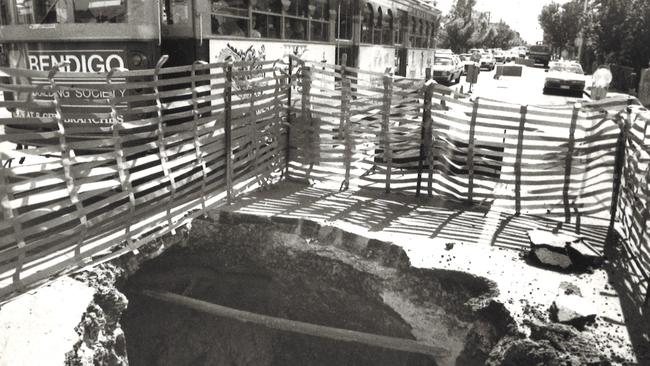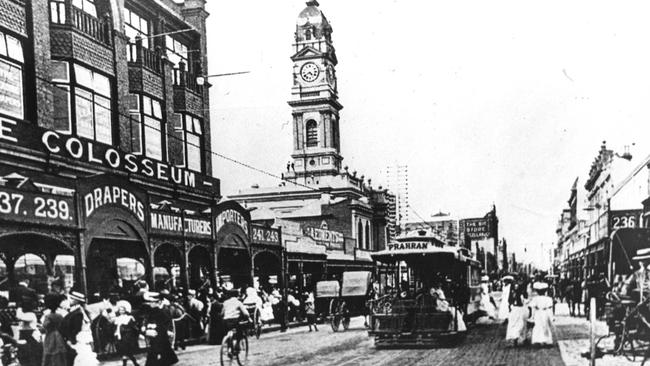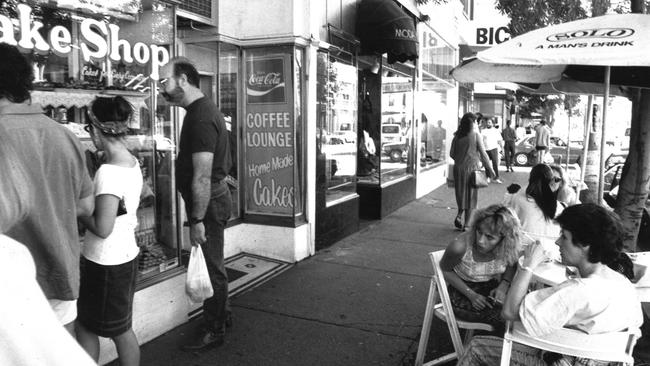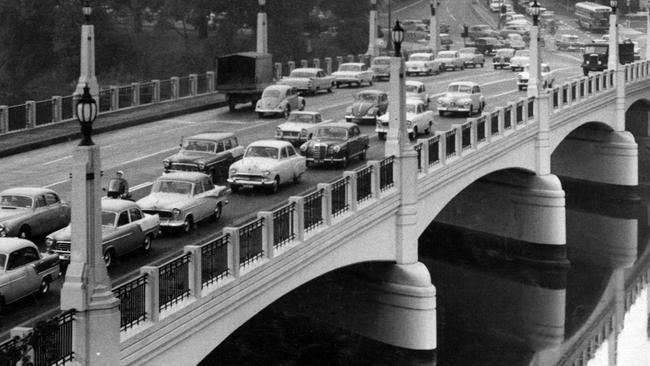From Led Zeppelin to sinkholes; the moments that defined Stonnington
When Led Zeppelin played Kooyong Stadium in 1972, event organisers were nervous about the weather. But that didn’t stop the fans from turning out. And the legendary band isn’t the only thing that has rocked Stonnington in Melbourne’s inner east.

Inner East
Don't miss out on the headlines from Inner East. Followed categories will be added to My News.
Stonnington has undergone a lot of change over the years.
Towering developments such as Lendlease’s residential towers in Orrong Rd, South Yarra’s Capitol Grand and Stonnington Council’s contentious Malvern East sport stadium are just a few of the projects that have attracted the ire of locals in recent years.
But did you know that Prahran Town Hall was once ravaged by fire, or that Stonnington Mansion got its name from it’s proprietor’s wife, who was born overseas?
Led Zeppelin even played to roaring crowds at Kooyong Stadium in 1972.
With the streetscape changing, we thought it’d be fun to take a trip down memory lane to revisit what Stonnington’s streets and locals looked like back in the good old days, as well as some of the news events that garnered headlines.
Here’s a few favourites pulled from the archives. Let us know what you think in the comment section below.
Enjoy.

Robert Plant and the boys from the legendary band Led Zeppelin rocked out at Kooyong Stadium in February, 1972.
Event organisers were nervous, but it wasn’t the band’s wild reputation that had them on edge or the massive crowds.
The event coincided with extreme wet weather the city was experiencing and just three days earlier Melbourne’s streets were turned into waterways during a flash flood after a thunderstorm.
Inclement weather was not enough to keep hordes of fans from Kooyong Stadium and despite a little rain the show was a roaring success.
It proved to be the only Melbourne show Led Zeppelin ever played, and after belting out hits such as Stairway to Heaven and Black Dog, the band boarded a flight at Tullamarine the next day and headed for Auckland.

The well-to-do Toorak set who call Victoria’s most expensive postcode home were surprised when a sink hole opened up in the middle of Malvern Rd.
A truck’s weight caused the road surface beneath it to collapse, creating a cavity that was so big it almost swallowed the truck whole.
A Prahran Council spokesman said at the time the road collapsed around an 80-year-old storm water pit after water washed out the road’s foundations.

Prahran Town Hall’s clock tower rises up in the background of this old streetscape photo taken of Chapel St in 1977.
The hall was built in 1861 according to the design of architects Crouch and Wilson, who won the tender for the project from the former Prahran Council.
A courthouse and lockup previously occupied the site, but in 1868 the courthouse was moved to a new brick building constructed at the back of the town hall, before being moved again in 1886 to the southeast corner of Greville and Macquarie streets.
The town hall’s famous clock tower was completed in 1863, but in January 1914 a fire destroyed the building’s main hall.
The town hall was completely refurbished in the 1980s, and Stonnington Council is undertaking further renovations at a cost of $29.1 million to turn the site into a function space. The town hall also houses a library

Stonnington Mansion, at 336 Glenferrie Rd, Malvern, is one of the most beautiful buildings in the municipality.
It was built by John Wagner, a partner of the Cobb & Co coaches, in 1890 and was named after the birthplace of Wagner’s wife, Mary, in Stonnington, Connecticut.
The family lived in the house until Wagner died in 1901, when it became Government House and served as the home of successive Victorian governors for 30 years.
It was also used as a school and a hospital before being bought by private owners on Christmas Eve, 2006.
The sale created tension among locals who wanted the building to be retained by the government so it could continue to be used as a public space.
The house sold privately again in 2018 for $52.5 million, with sources at the time suggesting it sold to a Chinese buyer.
The sale smashed Victoria’s highest property price record at the time — $40 million.

Traffic has died off since the coronavirus hit, but Chapel Street’s gridlock in pre-pandemic times was infamous.
Check out the old cars making their way down Chapel St in 1954.
The shopping strip’s still busy, but nowhere near the level of congestion locals are accustomed to nowadays.
Things could change, however, if a Stonnington Council proposal to remove on street parking is approved.

Melbourne is believed to have the largest tram network in the world.
The city had 250km of double tracks, 493 trams, 24 routes and 1763 stops as of May 2017, and with the city’s booming population it can only expect to grow.
Melbourne’s first electric tram was launched in October 1889 between Box Hill and Doncaster but the service was abandoned seven years later.
The electric tram, a mainstay of public transport in Melbourne’s CBD and inner suburbs today, was not reintroduced until 1906.

Chapel St is struggling with growing vacancy rates, particularly as Melbourne’s tough lockdown drags on.
But back in the day it was Melbourne’s go to destination for shopping and retail, and before the pandemic the strip was a popular spot for brunch at its chic cafes or a drink at one of its funky bars.
Restaurants, hairdressers, clothing shops and, of course, the famous Jam Factory cinemas, are still prime attractions that draw tourists and locals alike to the area.

This tram bore an advertisement for the new weekly real estate supplement launched in one of Melbourne’s main newspapers of the day, The Herald.
The paper was first published in 1840 by George Cavanagh under the masthead, the Port Philip Herald, but the name changed over the years to the Port Philip Morning Herald, the Melbourne Herald, before it finally became The Herald.
The Herald, by then a daily evening paper, and The Weekly Times were published by the same company for a couple of years before the business fell on tough times and were acquired in 1871 by Samuel Winter, a newspaper editor, and John Halfey.
The Herald group then bought the Melbourne Daily Telegraph and the Weekly Times, and in 1921 The Herald was the highest circulating paper under editor-in-chief Keith Murdoch.
Rupert Murdoch, Keith’s son, launched a new masthead, The Australian, in 1964 and The Herald Sun was established in 1990 as an amalgamation of The Herald and the Sun News-Pictorial.

Cars make their way across the Hoddle St Bridge in South Yarra in March 1961.
The crossing was a nightmare for commuters in peak hour for a number of years, as was the trip along Punt Rd, which was infamous for being the city’s worst bottleneck.
Work began in 2018 to overhaul the Punt Rd intersections with Swan St and Olympic Boulevard to create the state’s first continuous flow intersection.
Work was completed in September last year and the project was expected to slash journey times by removing right hand turns from the Swan St intersection and creating a new P-turn.

These beautiful ladies were beaming in February 1954 because they’d just been announced as placegetters in the 1954 Sungirl competition.
Lynette Quigley, 18, of Armadale, (on the right), came third, while Pam Henry, 17, of Ormond, (far left), came second.
Ann Renn, 18, of Ivanhoe, (centre) took out first prize.

This youngster was a student at Windsor Primary School and is pictured here saluting during an Anzac Day celebration in 1952.
When the school first opened it was called Prahran South Primary School, but the name was changed in 1891 to Windsor Primary School.
Nine teachers taught the 716 students enrolled at the school during its first year — equating to approximately one teacher for every 75 or so students.
A second storey was built on the school in 1890 but overcrowding remained a problem for a number of years.
A further two-storey wing was added in 1915 and the school’s peak enrolment hit 787 students in 1973, partly due to the development of nearby housing commission flats with attracted new migrants to the area.
MORE NEWS:


